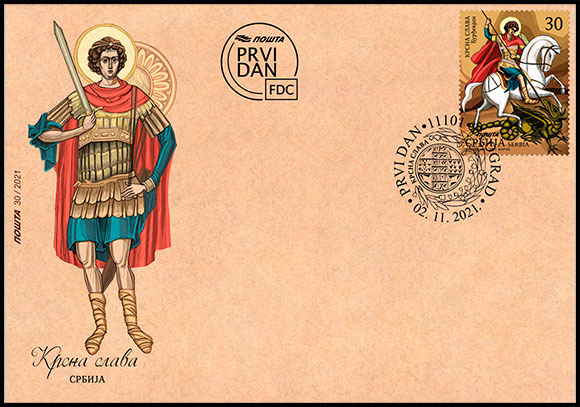
On November 2, 2021, Serbia Post issued a postage stamp in honor of the Serbian national holiday Slava.
Slava is a popular Serbian custom of celebrating Family Saint Patron’s Day. Each family has its own saint patron and protector, whose memorial day becomes the day of Slava for this family. On the day of Slava, the whole family gathers for a festive dinner, which includes traditional dishes - Slavsky kalach and kolivo (a memorial dish made from boiled wheat). Also, the whole family goes to church for communion. On this day, each house must fulfill two important duties: to pray to God for living and dead relatives and to receive and treat guests.
On January 27, the day of Saint Sava of Serbia, the Slava is also celebrated by the entire Serbian people, as one family, one clan. This holiday occupies one of the central places in the cultural and religious life of the Serbian people. The Serbs consider Slava to be one of the features of their culture and in 2014 it was included in the UNESCO Intangible Cultural Heritage List.
The stamp depicts Saint George the Victorious, astride a horse, slaying a dragon. For some families, the patron is Saint George, whose memorial day falls on May 6. Saint George is one of the most famous and revered Christian holy martyrs. According to legend, he lived in Palestine, was a soldier in the Roman army of the emperor Diocletian. During the persecution of Christians, he declared to the emperor that he was a Christian himself, for which he was sentenced to cruel torture and execution. On April 23 (May 6), 290, he was executed by order of the Emperor Diocletian.
The time of St. George's death coincided with the traditional Slavic spring rites, so two holidays - church and pagan - merged into one. St. George's Day or in Serbian Djurdjevdan is a widely celebrated holiday in Serbia. Dzhurdzhevdan is the border of winter and summer, wishes of health to households, happy marriage to girls and boys, fertility to livestock and a good harvest to the fields.
Until the 7th century, Saint George was portrayed exclusively as a standing or seated soldier. However, later there was a tradition of depicting St. George on horseback, killing a dragon or a snake with a spear, which symbolizes victory over evil.

Перейти в каталог


